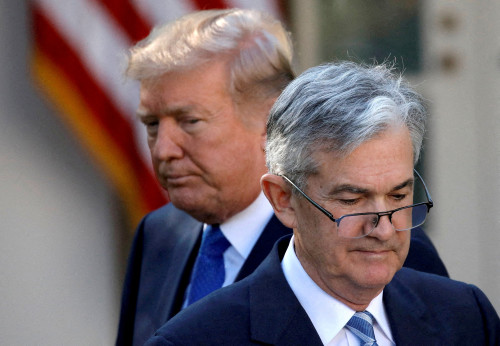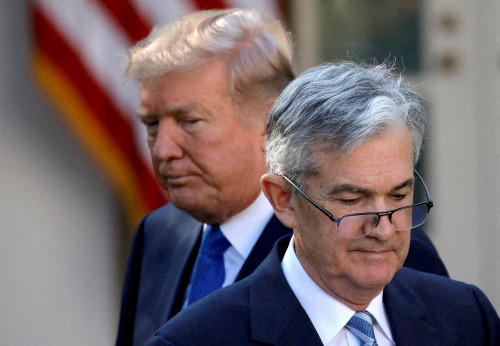By Ann Saphir
(Reuters) -U.S. President Donald Trump will visit the Federal Reserve’s headquarters in Washington on Thursday as tensions escalate between the administration and the independent overseer of the nation’s monetary policy.
The White House announced the visit late on Wednesday. “The Fed is working with the White House to accommodate their visit,” a spokesperson for the U.S. central bank said.
Trump has repeatedly demanded that Fed Chair Jerome Powell slash U.S. interest rates and has frequently raised the possibility of firing him, though the president has said he does not intend to do so. On Tuesday, Trump called the Fed chief a “numbskull.”
The rare presidential visit to the Fed is happening less than a week before the central bank’s 19 policymakers gather for a two-day rate-setting meeting. They are widely expected to leave the Fed’s benchmark interest rate in the 4.25%-4.50% range where it has been since December, as they wait to see how the economy performs in the face of the administration’s tariffs and other economic policies.
The White House did not say if Trump will be meeting with Powell on Thursday, and the Fed referred questions on the matter to the White House. Powell typically spends the Thursday afternoon before a rate-setting meeting doing back-to-back calls with Fed bank presidents as part of his preparations for the session.
Powell, who was elevated by Trump to the top Fed job in 2018 and then reappointed by former President Joe Biden four years later, last met with Trump in March when the Republican president summoned him to the White House to press him to lower rates.
The visit on Thursday also is taking place as Trump battles to deflect attention from a political crisis over his administration’s refusal to release files related to convicted sex offender Jeffrey Epstein, reversing a campaign promise. Epstein died in 2019.
White House officials have ramped up Trump’s pressure campaign on Powell in recent weeks, accusing the Fed of mismanaging the renovation of two historic buildings in Washington and suggesting poor oversight and potential fraud.
White House budget director Russell Vought has pegged the cost overrun at “$700 million and counting,” and Treasury Secretary Scott Bessent called for an extensive review of the Fed’s non-monetary policy operations, citing operating losses at the central bank as a reason to question its spending on the renovation.
The Fed’s operating losses stem from the mechanics of managing its policy rate to fight inflation, which include paying banks to park their cash at the central bank. The Fed reported a comprehensive net loss of $114.6 billion in 2023 and $77.5 billion in 2024, a reversal from years of big profits it turned over to the Treasury when interest rates – and inflation – were low.
The Fed, in letters to Vought and lawmakers backed up by documents posted on its website, says the project – the first full rehab of its two buildings in Washington since they were built nearly a century ago – ran into unexpected challenges including toxic materials abatement and higher-than-estimated materials and labor costs.
‘MAINTAIN HIS INDEPENDENCE’
Ahead of Trump’s visit, Fed staff escorted a small group of reporters around the construction sites. They wove around cement mixers and construction machines, and spoke over the sound of drills, banging, and saws. Fed staff pointed out security features, including blast-resistant windows that they said were a significant driver of costs. Tariffs and escalations in material and labor costs also made the renovations more costly than originally estimated, staff told the group.
The renovation project started in mid-2022 and is on track to be completed by 2027, with the move-in planned for March, 2028. A visit to the roof of the Eccles Building – a point of particular scrutiny by White House critics that the renovations were ostentatious – revealed an impressive view of the Lincoln Memorial and the National Mall, the pool report said.
Staff explained that rooftop seating, although inexpensive, had been removed because of the appearance of it being an amenity and was one of only two deviations from the original plan. The other was the scrapping of a couple of planned fountains.
The White House’s deputy chief of staff, James Blair, said this week that administration officials would be visiting the Fed on Thursday. Senate Banking Committee Chair Tim Scott, a Republican who sent Powell a letter on Wednesday asking a series of questions about the cost and other details of the renovation as well as Powell’s own statements about it, is part of the visit as well.
Market reaction to Trump’s visit was subdued. The yield on benchmark 10-year Treasury bonds ticked higher after data showed new jobless claims dropped in the most recent week, signaling a stable labor market not in need of support from a Fed rate cut. Stocks on Wall Street were trading mostly higher.
Trump’s public criticism of Powell and flirtation with firing him have previously upset financial markets and threatened a key underpinning of the global financial system – that central banks are independent and free from political meddling.
His visit, happening against the backdrop of his antipathy for Powell, contrasts with a handful of documented previous presidential visits. Then-President Franklin Delano Roosevelt visited the Fed in 1937 to dedicate the newly-built headquarters that today make up the construction site that Trump is visiting. Most recently, former President George W. Bush went to the Fed in 2006 to attend the swearing-in of Ben Bernanke as Fed chief.
Republican Senator Mike Rounds said on Thursday he saw no problem with Trump’s visit, though he added that Powell’s independence as Fed chief is “critical for the markets. I think he’s done a good job of that.”
“I think the more information the president can glean from this, probably the better off we are in terms of resolving any issues that are outstanding,” Rounds said, noting that Powell had indicated “that they have had a significant amount of money, just in terms of foundation work and so forth, that was not anticipated to begin with.”
Former Fed chiefs Janet Yellen and Bernanke this week wrote an opinion piece in the New York Times warning that the public’s belief that the U.S. central bank is willing to make hard decisions based on data and independent of politics “is an important national asset. It is hard to acquire and easy to lose.”
Economic experts widely agree.
“As we’ve seen through the disinflation process that has been taking place over the last few years, the credibility of central banks around the world has been instrumental in anchoring inflation expectations and in bringing down inflation across many countries in the world,” International Monetary Fund spokesperson Julie Kozack said on Thursday. “And it is also important that independence, of course, must coexist with clear accountability to the public.”
Asked about Trump’s visit to the Fed, Republican Senate Majority Leader John Thune told reporters: “He’s going today? Like, just to tour it? Well, I mean, I think that obviously he has strong views about Fed policies, which are shared by a lot of people with respect to interest rates, etc. But again, I think he has indicated on multiple occasions now that he has no intention of firing the chairman.”
(Reporting by Ann Saphir, Bo Erickson, David Lawder, David Morgan; Editing by Chizu Nomiyama and Paul Simao)


